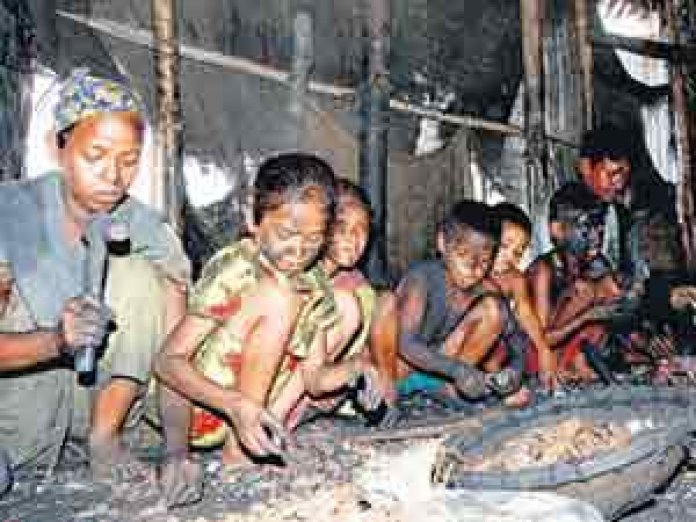Hello Readers!
Recently the NITI Aayog released the country’s first Multidimensional Poverty Index (MPI). The report stated that 25% of Indians are poor on the MPI metric. Over 50% Bihar is poor in the index based on health, education, standard of living. We will discuss other details about the report and the various facts stated about the poverty situation in India.
Read the blog carefully to know all about the report.
About the Report
The report defines poverty as the deprivation in crucial and basic parameters of health, education and living standards. The report is based on the National Family Health Survey 4 (NFHS-4), which was conducted between 2015 and 2016.
It is developed by the NITI Aayog in consultation with 12 ministries and in partnership with state governments and the index publishing agencies, namely, Oxford University’s Oxford Poverty and Human Development Initiative (OPHI) and United Nations Development Programme (UNDP).
The index measures poverty levels in over 700 districts which is classified on the basis of 12 indices related to three equal weight dimensions: health, education and standard of living.
Why NFHS-4 ?
Data collected during the NFHS-4 (2015-2016) corresponds to the period before the full roll out of government schemes on housing, drinking water, sanitation, electricity, cooking fuel, financial inclusion, and other major efforts towards improving school attendance, nutrition, mother and child health, etc. therefore it serves as a useful source for measuring the situation at baseline i.e. before large-scale rollout of nationally important schemes.
Indicators of MPI
The multidimensional poverty index is calculated using 12 indicators — nutrition, child and adolescent mortality, antenatal care, years of schooling, school attendance, cooking fuel, sanitation, drinking water, electricity, housing, assets and bank account — that have been grouped under three dimensions namely, health, education and standard of living.
Key Facts
In its first Multidimensional Poverty Index (MPI) report, the Niti Aayog stated Bihar, Jharkhand and Uttar Pradesh to be the poorest states in the country. They were followed by Madhya Pradesh and Meghalaya in the index.
According to the report, 51.91 per cent of the population in Bihar is poor, followed by 42.16 in Jharkhand, 37.79 per cent in Uttar Pradesh, 36.65 per cent in Madhya Pradesh and 32.67 per cent in Meghalaya.
Among Union territories, Dadra and Nagar Haveli ( 27.36 per cent), Jammu & Kashmir and Ladakh (12.58), Daman & Diu (6.82 per cent) and Chandigarh (5.97 per cent) have emerged as the poorest in the country.
Puducherry, with 1.72 percent of its population as poor, Lakshadweep (1.82 per cent ), Andaman & Nicobar Islands (4.30 per cent) and Delhi (4.79 per cent) have fared better.
The highest number of malnourished people have been reported in Bihar, followed by Jharkhand, Madhya Pradesh, Uttar Pradesh and Chhattisgarh.
Bihar also ranked at the bottom in various other categories, including percentage of population deprived of maternal health, percentage of population deprived of years of schooling, school attendance and percentage of population deprived of cooking fuel and electricity.
States that have registered lowest poverty across the country are Kerala with only 0.71 percent of its population falling in that category, followed by Goa (3.76 per cent), Sikkim (3.82 per cent), Tamil Nadu (4.89 per cent) and Punjab (5.59 per cent).
Importance of MPI for India
The development of the National Multidimensional Poverty Index of India is an important contribution towards instituting a public policy tool which monitors multidimensional poverty, informs evidence-based and focused interventions, thereby ensuring that no one is left behind.
The highest number of the deprived are in cooking fuel and sanitation at 58.5 per cent and 52 per cent, respectively. This means more than half the population were poor on these two counts.
Next came housing, which had 45.6 percent of the population as deprived during 2015-16, followed by nutrition (37.6 per cent), maternal health (22.6 per cent), drinking water (14.6), assets (14), years of schooling (13.9), electricity (12.2), bank account (9.7), school attendance (6.4) and child and adolescent mortality (2.7).
India’s ranking in Global Multidimensional Poverty Index 2021
The MPI for 2021, launched by the United Nations Development Programme (UNDP) and the Oxford Poverty and Human Development Initiative (OPHI), showed that 27.9 per cent of India’s population were multidimensionally poor. The country ranked 62nd out of 109 nations on the index. This index was based on 10 indicators such as lack of improved drinking water, adequate nutrition or at least six years of schooling.
With this we come to the end of this blog. Stay tuned for more updates.




